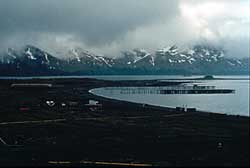
Attu Island is the site of the only World War II land battle in North America. The island was subsequently used as a launching site for American bombing missions to Japan's home islands. Many American combat aircraft were lost during the Aleutian Campaign, both to enemy action and to fierce weather conditions. Today, evidence of the desperate battle is found on its eastern end: thousands of shell and bomb craters in the tundra, Japanese trenches, foxholes and gun encampments, American ammunition magazines and dumps, and spent cartridges, shrapnel and shells are located at the scenes of heavy fighting.
Attu is at the western end of the Aleutian Chain, 1,500 air miles southwest of Anchorage, 500 miles east of the Russian mainland, and 750 miles east of the Kurile Islands. Located between the cold Bering Sea and the warm Japanese current of the North Pacific, Attu's volcanic mountains and tundra valleys are subjected to year-round storms and dense fog that make it one of the most forbidding regions in the world. The island has no trees and the lower levels are covered with spongy tundra and a variety of plants. The principle water features of eastern Attu are Holtz Bay, Chichagof Harbor and Massacre Bay. The Aleut village of Attu stood at the head of Chichagof Harbor. It was destroyed during the battle and no trace remains. Archeological sites of earlier Aleut settlements are also found there. The Japanese forces landed at Holtz Bay in June 1942, constructed defense positions there, and established headquarters eventually at Attu village.

The Japanese occupation of Attu, coordinated with the June 1942 attack on Midway, marked the peak of Japan's military expansion in the Pacific. The occupation of this remote part of the North American continent created great alarm among Americans, however briefly, that it was the beginning of an invasion of the United States through Alaska. The American recapture of the island was a morale boost for the nation. In May 1943, U.S. forces landed on the north and south coasts: at Red Beach and Austin Cove on the north, and Massacre Bay on the south, bitter fighting occurring until the two forces joined in Jarmin Pass. The Americans next captured the rugged hill country known as Fishhook Ridge, then began a drive through Clevesy Pass toward Chicagof Harbor. The battle ended when the Japanese made a last fanatical charge on the night of May 29 against the pass, which ended in their annihilation--only 29 of 1,000 survived. The next morning, May 30, Japan announced the loss of Attu. Of the American strength of 15,000, 550 were dead and 1,500 wounded, and another 1,200 Americans were casualties to Attu's climate. At the Coast Guard station on Massacre Bay is a memorial dedicated to the American naval, air, and ground forces that recaptured Attu.
American army engineers and naval Seabees quickly constructed airfields, roads and camps over the eastern end of the island, of which vivid evidence remains today on the slow-to-heal tundra. Besides the runways and ammunition magazines, a remarkable feature that still exists is a 3,133-foot-long, bombproof storage tunnel cut through a ridge near Clevesy Pass. Near Clevesy Pass, on Engineer Hill (the last goal of the Japanese) are trenches, foxholes, tent pegs, barbed wire, coal pits and other relics of the war. After the reconquest, the 11th Air Force made its first attack on Japan's home islands with eight B-25 bombers on July 10, 1943. Other attacks followed. The Navy constructed both land runways and a seaplane base for patrol bombers and flying boats west of Massacre Bay and at adjacent Casco Cove. For the duration of the war, naval aircraft made their lonely patrols over the North Pacific. As at Alexai Field, the Navy's two land runaways were first covered with steel mats. By 1944, however, asphalt had been laid and the Navy made the runways available to Army planes as well as its own, and the 11th Air Force established maintenance facilities there.
Visit the National Park Service Travel American Aviation to learn more about Aviation related Historic Sites.
Last updated: October 23, 2021
